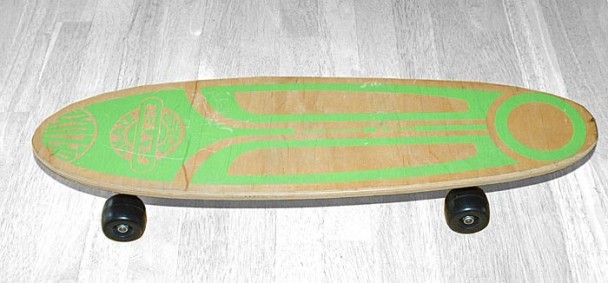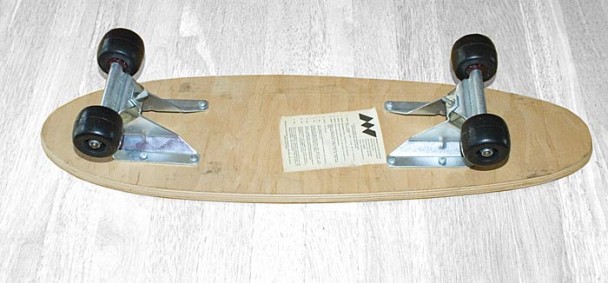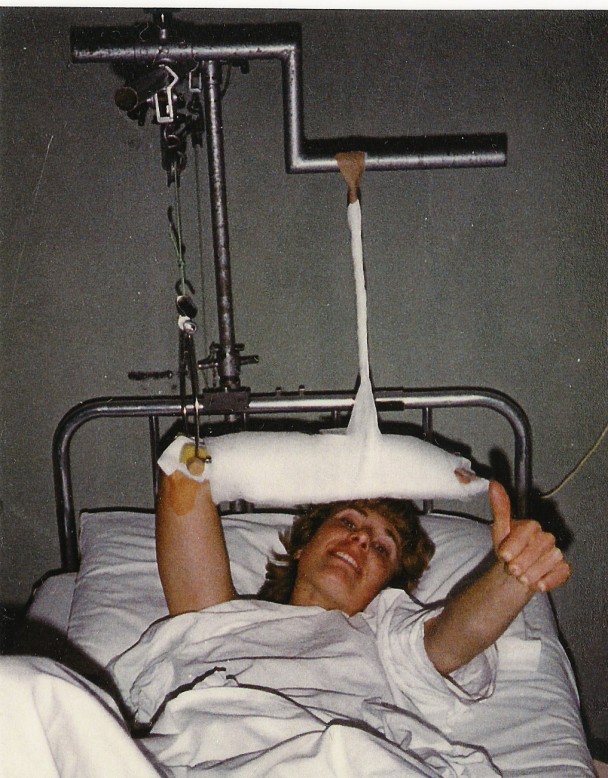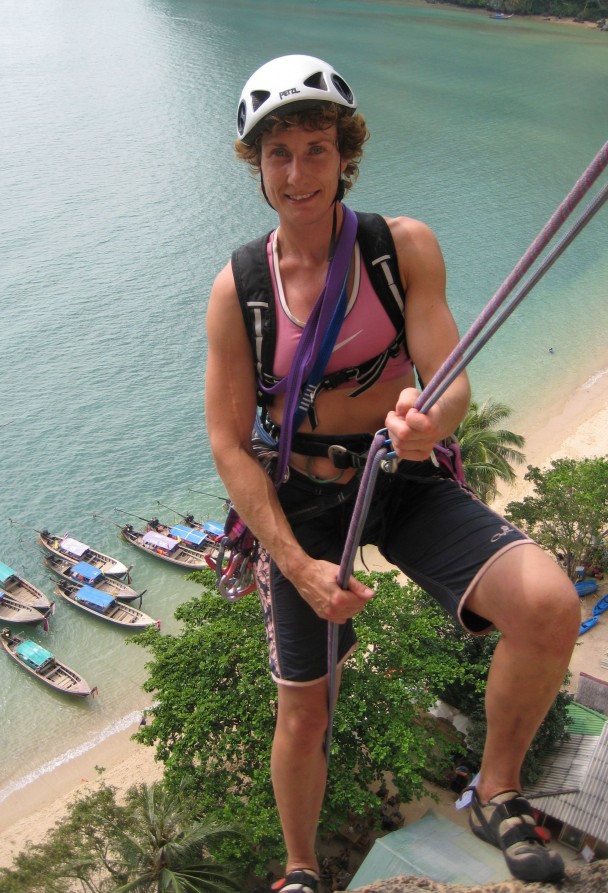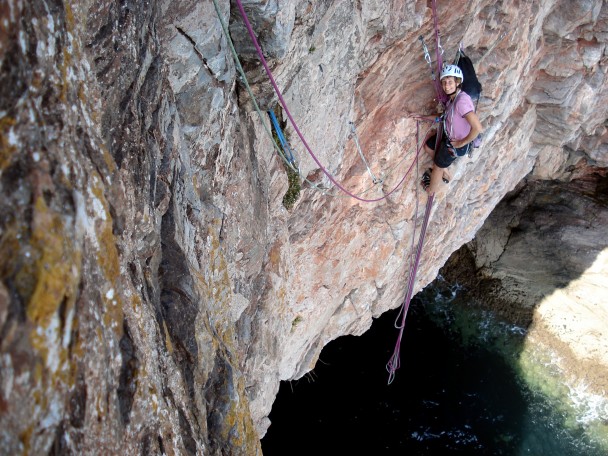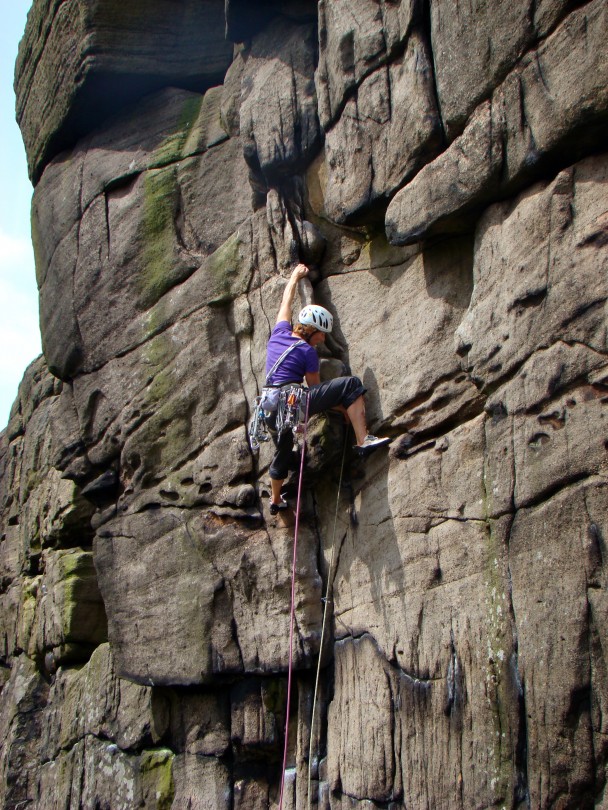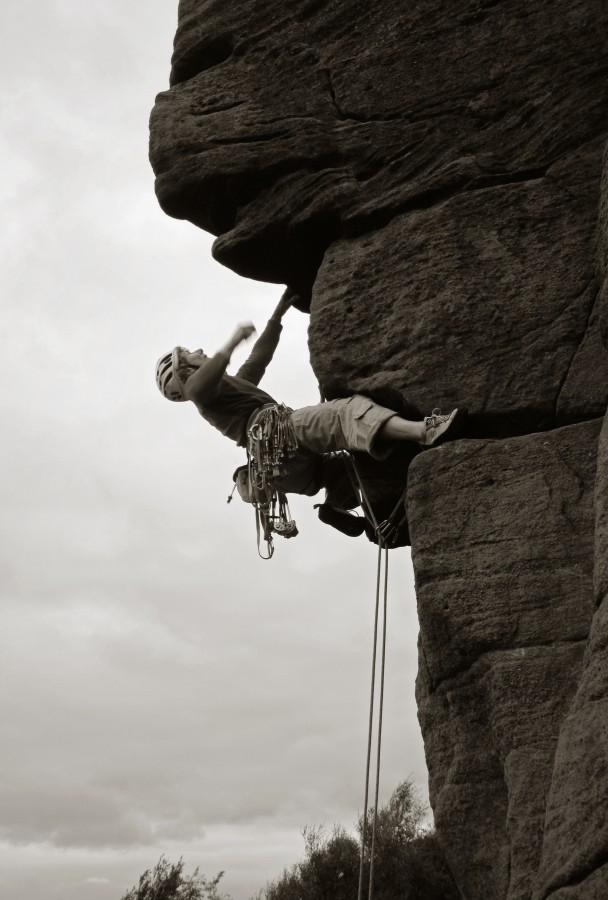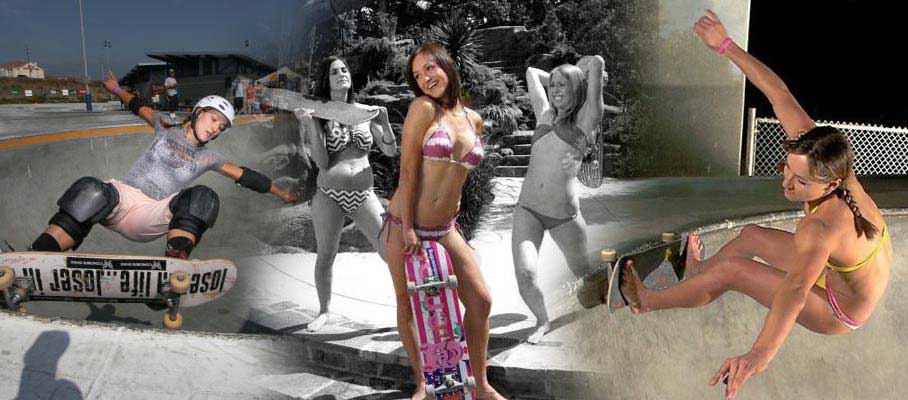
Sue – invert on Perranporth Vert, Cornwall, UK Photo: Nicky Tidman
I’ve always believed that life isn’t about staying within one’s comfort zone; it’s about pursuing something new and challenging to evolve and learn. No matter the amount of bruises and scratches, you gotta get up and go at it again, right?
After interviewing one of UK’s skate legends, Sue Hazel, I immediately thought of how she emanates this sort of thinking by how she lives her life. From skating to climbing, she has had the superior focus to push herself hard in whatever she wants to master. From the beginning, growing up humbly didn’t prevent her from buying her first board; injuries may have delayed her but have never made her quit from fear and her fire for action has grown from skate ramps to scaling cliffs in domestic and international rock climbing adventures.
As one of the few women skaters in England in the late 70’s and 80’s excelling in both vert and freestyle (which is not common even these days), she has been a crucial link and valuable historian in holding fast to the legacy of female skating from that era. Priceless vintage footage (that was filmed by Sue’s sister under her direction) was recently used in the new, full-length documentary by Jenna Selby – ‘As If, And What?’, UK’s first skate video featuring notable, skilled and bold women, including Sue.
In this interview, she gifts us with a tidbit of her experiences and leaves us with great insight on what it was like to be a female skater when it was just becoming heard of.
And lastly, I want to mention, from looking at some of these great, vintage photos…LOVE the knee-high socks, Sue. If you ask me, that style should come back again. :)

Double 180 Rail Flip – Ventura Beach, 1987 Photo: Sean Goff
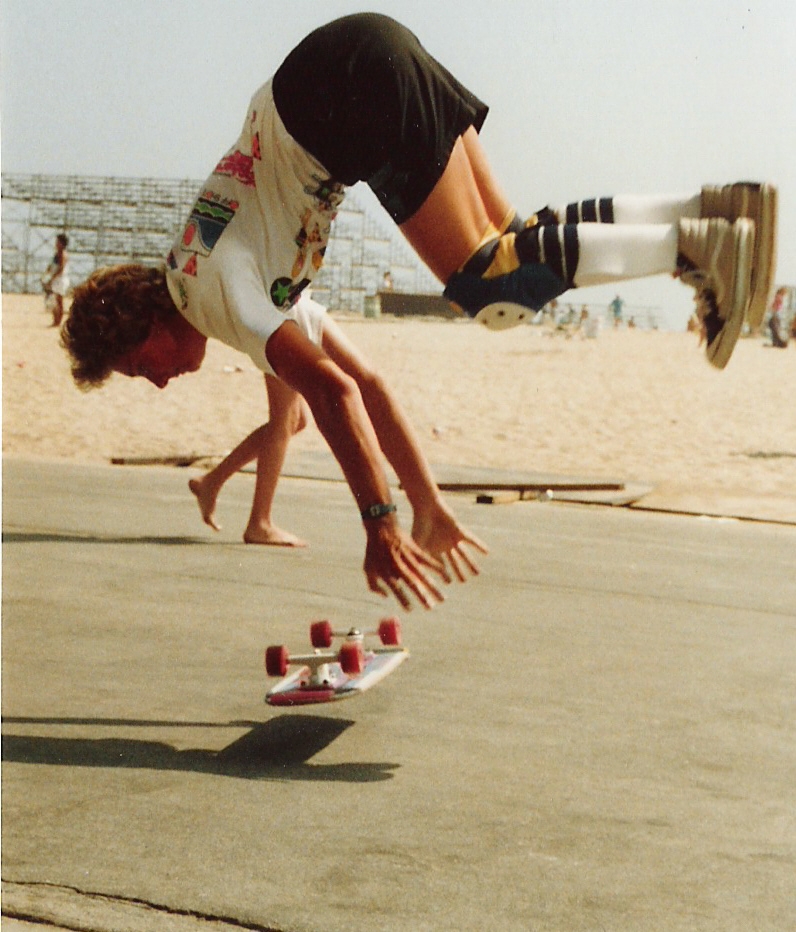
Handstand fingerflip in Huntington Beach, CA 1987
RRRG: Where were you born? Raised? Live now?
Sue: I was born in the New Forest, Hampshire, in the UK. I’ve moved 4 or 5 times, though I’ve yet to cross the county border to live, although my travels take me far beyond the local area.
RRRG: What was growing up in the UK like for you and within your family and peers?
Sue: Growing up in the UK, I had a normal childhood, with siblings Nicky and Tim and went to the local Comprehensive School. My parents didn’t have much spare money when we were young, but despite this, always got us involved in trying out different sports and activities as much as they could. This is something for which I will be eternally grateful, as I’m sure it must have fueled the interests I later developed, though perhaps not necessarily in the areas my parents had hoped for….
We would have big family walks in the forest, which usually ended up with a rope being slung over a tree, strategically placed over a stream; inevitably someone would end up falling off into the water and going home wet before the day was over.
At school I was pretty much the individual type; had a few close friends, but didn’t really get into going around in a large group or wearing all the latest ‘must have’ gear.
RRRG: How did your interest in skating come about?
Below, ‘Surf Flyer’ board – Sue’s first ride
Sue: In the late 1970’s, there was a surge of Skateboarding interest in the UK, as the wave of influence/craze filtered over from the States, simultaneously hitting Europe. I saved up and got my first board and was the immensely proud owner of a ‘Surf Flyer’ (see pic).This board would be seen as the pits now, but to me at the time; it was the first magical step into something which would change my world and shape my life for years to come. Like most kids of that era, I couldn’t get enough of it and would rush home from school each day, to spend each evening outside (if it wasn’t raining) trying to learn to kick-turn or something. This would now seem such basic stuff, but you have to remember that it was a completely new sport at the time; just mastering good flowing turns or smooth tic-tacs was an achievement. However, the fuse was lit; I was doing it, reading about it, dreaming it.
There were no videos, DVD’s, internet or anything like that, we had magazines though, and they were the only source of written published communication with any skaters from outside your own area.
Public skateparks were only just starting to materialise, we skated in the street and on the pavement, that was, until the police were called out by the neighbours, even if you were making no noise or disturbance whatsoever. Just you being out there, was catalyst enough to warrant a phone call to ‘get the kids off those awful skateboards’; such was the public distaste for our harmless fun.
A few years later, once public furor started to wain, I continued my efforts to learn any tricks that captivated me, one of them being the rolling handstand on a board, a feat that at the time, I eventually wired well enough to navigate the entire length of our quiet neighbourhood cul-de-sac, which was a bend on a slight hill. You can only imagine some of the more aloof residents of the street glancing up from their Sunday paper, to see a pair of feet, upside-down, gliding past their windows repeatedly – undoubtedly in my quest to improve my distance record each time. I must’ve been an embarrassment to my parents…

Cross-foot pogo, Ventura Beach 1987 Photo: Sean Goff
RRRG: hahhaa…I love it. Were there any people in particular that stood out that inspired you?
Sue: As a youngster, I didn’t get to see many influential skaters, as most of my skating was done in my road, though every fortnight, I’d put my pocket money towards a bus ride to Southsea Skatepark, to meet other local skaters and learn to ride bowls. There were many skaters there who were all influential for different reasons and I can’t list names for fear of missing someone out.
Seeing any other female skater was always an inspiration, there weren’t too many.
RRRG: Were there many females involved at that time?
Sue: Quite a few during the real popular phase, but the number quickly declined as most people, guys and girls, ditched their boards after the bubble burst of the initial skate explosion.
RRRG: How did you family/parents feel about you taking on a potentially dangerous sport?
Sue: I’d taken on skating before my parents made any conscious decision about whether it was dangerous or not. The issue was more about the social unacceptability of the activity than anything else. This was in common with almost any other skaters’ parents at the time though; it was simply not seen as a worthy activity to pursue, in spite of the great effort it took to master it.
The term ‘extreme sport’ was not part of the general publics’ vocabulary back then!

Double 180 Rail Flip, Farnborough, 1984 – still on homemade decks – with broken arm on the mend
RRRG: Do you feel like skating…and the culture that follows it has changed immensely? If so, in what ways?
Sue: Skating is now an activity that has become perfectly acceptable in most peoples eyes. It influences fashion, music and sells big-time. Who could ever have imagined that in the 1970’s? I recently sold my entire collection of skateboard mags, and it was a real trip, both socially and historically re-reading how the first generation skate boom developed, flourished, and died, then the subsequent further growth and maturing of the whole industry and skate scene during the second wave of interest..
RRRG: Also, in terms of the skateboards that are designed for high performance…what differences do you see from the boards you were first skating on and the ones you have been on recently?
Sue: The boards we first rode were toys, they would never have made it possible to ride a halfpipe properly. Safety gear was also pretty hilarious when you look at some of the corny adverts depicting state of the art equipment at that time. Knee pads had no plastic caps to aid sliding out of a bailed trick on a ramp. Imagine pulling a big air now, knowing you had no option to knee-slide out if it all went pear-shaped? It simply wouldn’t have been possible for skating to progress to the level it has, without simultaneous development in safety equipment.
Ironically though, so many street skaters seem to ditch the pads anyway, maybe they look way too uncool, maybe it’s too restricting? I was never that fond of big scabs on my knees anyway…
RRRG: Do you think there is still a long way to go for women to become recognized as serious skaters?
Sue: It’s always been the same. Maybe women are under represented as they are a minority in the sport anyway, or perhaps there’s a deeper political agenda in magazine editors policies? At the end of the day, I guess the overriding decision on what to print, comes from the biggest advertisers needing coverage for their riders?
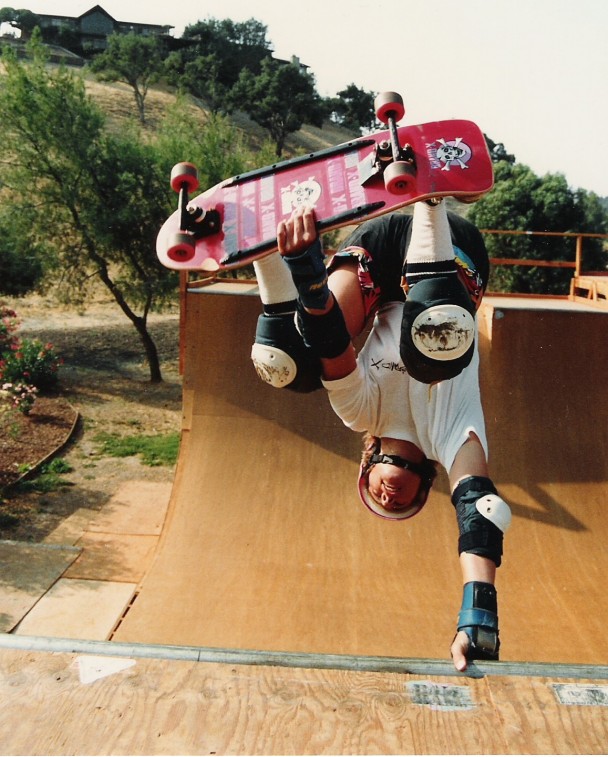
Hand plant at Paige Mill – 1987 – Photo: Stephanie Person
RRRG: As one of the few women skating at the time you started, how were you treated and viewed?
Sue: I can’t really remember any particularly bad vibes from other skaters, I was just one of the crowd; albeit a girl. I loved travelling and visiting different scenes, and still do.
RRRG: When you were first learning tricks, how did you go about it? For instance, that high jump in the photo. Did you start little by little? Or would you just go for it?
Sue: I generally would try to break the trick down in my mind first and visualise it. Learning anything for the first time, I’d try to get a feeling for the trick, by trying it low down on the ramp, or in the case of the high jump, having the bar only inches above the board to start with, to get an idea on timing the jump and landing it. Then it’s a matter of adjusting to faster speeds, by taking off earlier etc. Lots of analysis, frustration and bails, then it starts coming together. Persistence is the word.
RRRG: Were you ever involved in competition? If so, were you competing against boys? What kind of competitions? Vert? Street? Both?
Sue: I competed a bit during the 1980’s onwards. I mostly did freestyle and ramp, a rather odd combination in some ways as it was a very different crowd doing each type of skating. Vert skaters were loud, Freestylers were more introspective. The English Skateboard Association Comps at this time though were mostly about fun, so a lot of people did all the disciplines for a laugh. It was the era that most of the public thought that skateboarding was dead…
In 1986 though, The English Skateboard Association through the organisational genius of Derry Thompson, managed to obtain funding by the Sports Council to take a team from England to compete in the Transworld Skateboarding Competition in Canada. It was a real attempt to legitimise Skateboarding in the eyes of the governing body of sport and was a tremendous opportunity to attend a major event that we would otherwise have never managed to be able to fund by our own means. Skateboarding had arrived; we had our own team tracksuits, somewhere to kip each night, which didn’t involve a floor or sofa (though I do remember it had resident fleas!) and the venue was at the Expo Exhibition Site in Vancouver, a major outdoor showcase for the sport.
RRRG: Did you ever feel nervous competing or trying a trick? If so, how would you resolve these feelings and gain the confidence to follow through?
Sue: Competing in Freestyle was always a bit more nerve-wracking than vert, you always felt more likely to fall over your feet. When they introduced the *jam format for vert contests, it made it much more like a good heated skate sesh, only without the **snaking. Pre-contest snaking though would still abound – I never did really get a buzz from that, perhaps that’s being girlie or just having a sense of self-preservation?
Trying a new trick, it seemed to be a case of learning in increments, then getting so close that you had to commit to landing the thing. I remember the first time I really committed to coming in backwards out of a rock fakie on the Farnborough vert ramp – I slammed so hard on my back! After a while sitting out recovering, I got on the board again to get it wired, just made darn sure in future attempts I didn’t let my wheels hang up on the coping…
Arm in traction from a ski accident, not a sk8 one! Chiavenna Hospital, Italy Photo: Nicky Tidman
One of the worse slams later on in my skate development, was coming back into the ramp from a frontside rock on 1½ft of vert; you have to be so dialled on those that if you miscalculate or your foot shifts, you know you’re gonna die! I wrecked my ankle for a while on that one.
Another time, I managed to knock myself out during a demo in the states and woke up in an ambulance, but I don’t remember anything, so that doesn’t count. Ha Ha!
Something I would have really appreciated during my competitive days would have been a trainer or mentor, everything was so self-generated. It’s great that you can even have skateboarding lessons now.

Frontside Boneless – Canteloes, London, 1985
RRRG: How did skating affect your life?
Sue: It has enhanced my life in so many ways. I’ve travelled to places I never would have seen without being involved in skating; France, Germany, Sweden, Scotland, USA and Canada, Bognor Regis (The last ones serious!)
Meeting people from vastly different backgrounds from my own has I hoped developed a humility and appreciation for people who have alternative beliefs and attitudes than my own, an acceptance of people’s differences. One of the really recurring frustrations of training and performing at skating during the 1980’s was the demeaning shallow comments and attitudes from ignorant people who had no clue as to how much effort it took to do this activity well. It said more about them, than about our skating. I wowed I’d never undermine someone for their choice of lifestyle, sport or interest in future, because of the judgemental attitude we had to contend with whilst trying to pursue something that, to us, was very worthwhile.
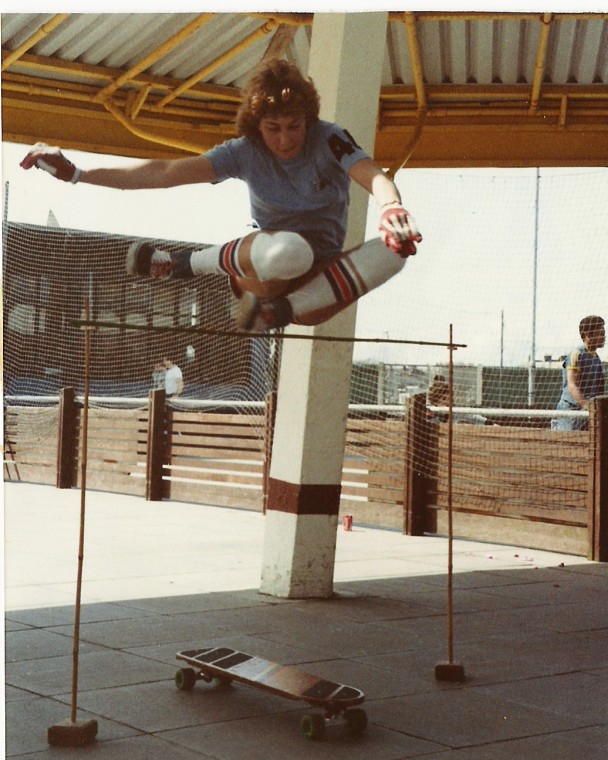
Highjump – English Skateboard Association Competition, Southsea, England, 1983
RRRG: In what ways did you participate in the documentary movie, ‘As If, And What’?
Sue: I submitted a large archive of filming taken during my formative years of skating. I’m just thankful that it will be viewable in a modern format now, rather than collecting dust in my antiquated cine film collection. Thanks Jenna for your sterling work presenting my old footage in ‘As if and What’.
RRRG: How did you get footage of yourself skating from back in the day? Was this a friend filming you? Or for a project at the time?
Sue: It’s mostly the work of my longsuffering sister Nicky (big up Nicky Tidman), to whom I will be eternally grateful. There would otherwise be no movie record of my skating during this period. I would cajole, pester and direct my photographer frequently to try to get the result I envisaged. So big thanks Nic.
RRRG: At one point did you retire your skateboard (if you have)……or do you still go out and skate often?
Sue: I hardly skate at all now, due to spending a lot of time climbing and not being able to get out in the evenings due to work, but will always skate. I’d never give my board away…hopefully the situation may be able to be resolved at some time in the future though I’m also keen to do more kiting. I’ve got a traction kite and a mountain board, but would like to get into the water too. The thought of all that airtime…
A very fit-looking and happy Sue; testimony to how climbing and skating can keep you young! Reaching the top of “Humanility”, multi-pitch route high above Tonsai Beach, Thailand Photo: Claire Peltier
RRRG: What are you other hobbies?
Sue: Rock climbing, dabbling in a bit of Slackline, Yoga, though it’s more of a lifestyle than hobby, as I’m sure my brilliant teacher James Robbins would attest.
I run a bit, but that’s not really a hobby either.
RRRG: How did your passion for climbing come about?
Sue: I was introduced to it by an Outdoor Activity Group that I used to belong to: ‘The Outcasts’ (great name eh?). They had a bouldering session each Friday evening at the local wall. A friend who was active in this group acquired a leading rack and asked me if I’d like to climb outdoors. It wasn’t long before I became hopelessly addicted. Paul, I am forever indebted (Big up Paul Lloyd)
RRRG: What kind of climbing? Sport? Traditional? Alpine? Ice? All the above?
Sue: Sport, Trad, Deep Water Soloing. The winter stuff is something that I must give a go at some point, though I have Raynaud’s Phenomenon, so keeping warm is a bit of a challenge anyway, without purposely heading out to the cold…

The delectable slab and corner of “Gogarth” E1, Anglesea, Wales, UK, Summer 08 Photo: Pete Saunders
RRRG: What areas have you climbed in?
Sue: Southern, Central and Northern England, Wales, France, Spain, Thailand, Kalymnos (Greek Island), Turkey, Mallorca, Sardinia, Sicily. An awful lot more to explore yet though…
RRRG: You recently came back from France – what was that trip like for you? Where did you climb?
Sue: We were visiting the Haute Provence area (first time for me), a beautiful area of Southern France famed for its quality of routes. It’s too hard to pick a single climb, there were so many standouts. Oddly though, one of the more abiding memories at the tail end of the trip, was on a whistle-stop visit to Fontainbleau for a bit of bouldering on the way back to the Ferry Port. I spent ages on a diminutive boulder problem, of no great technical accolade, and just couldn’t seem to clock the right body positioning, hand and foot sequences or something. It just felt wrong when I kept trying it; rock boots on tiny, barely existent holds. Our visit was drawing to end and though I really thought I had no hope of ‘sending’ the darn thing, I just couldn’t leave it alone. I was still persistently experimenting with things to find something that worked, when all of a sudden, I was on the penultimate hold and it was all over. I lost count of the amount of tries I’d had beforehand, but that wasn’t the point. My efforts had finally been rewarded.
RRRG: What are some of your future goals?
Sue: To gain control of the amount of hours I work and commute, as at the moment it’s seriously hindering my ability to train the hours required to improve at my sport.
RRRG: What do you consider the most valuable things in life to you at this time?
Sue: My Family, Friends and Health. Material things do not bring happiness.
RRRG: ANNNND…… if you could only eat one food forever…..what would it be?! :D
Sue: Chocolate! Is the instinctive answer!
Though I really do love my veggies and fish too, so the sensible pragmatic me, would say this is an impossible question to answer and I’d insist on a well-balanced healthy diet.
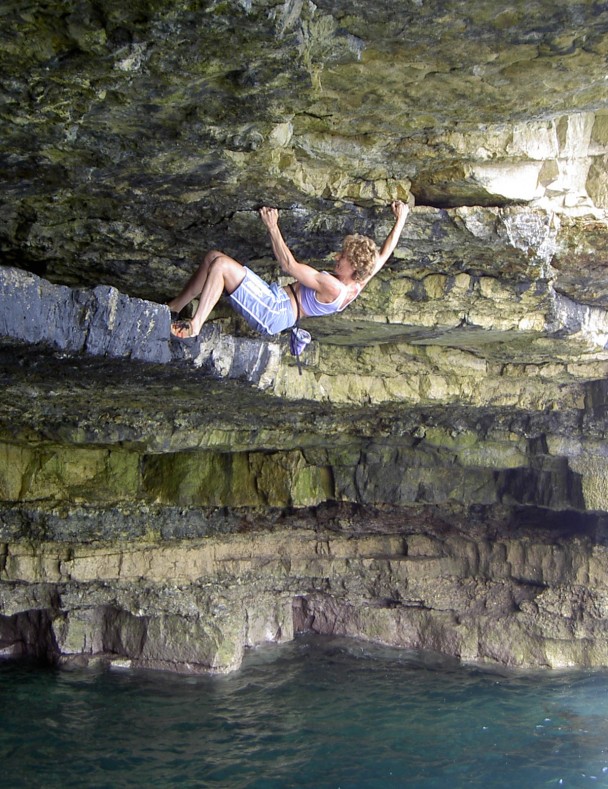
Deep water soloing on “Octopous Weed” Portland Dorset, UK Credit: Tim Hammell
RRRG: Do you have any shoutouts to anyone?
Sue: Actually, I’d like to make a shout-out to you Christine, for your immensely positive and enthusiastic approach to what you do. For your belief that I might actually have something interesting to say, when I didn’t initially think that I had! For making your interviewees feel valued and enthused about their contribution.
A definitive acknowledgement to everyone I’ve had the privilege to share a skate sesh with over the years; too many to mention.
To all my past and present climbing partners, thank you so much for all the fantastic days out on the crag and mountain, with a special mention for Pete Saunders.
Other than that, as a slightly quirky thing I’d have to say the St. Swithun’s School catering staff, who make the best school lunch ever, (the school where I work). They are also extremely unlikely to ever read this!
RRRG: Too cute…hahaa…thank you immensely Sue. Interviewing you has been a true pleasure and you have a world of knowledge to share – look forward to hearing about more of your future adventures!
Terms referenced:
*Jam Format – Skating in a competition one after another as each rider bails, without timing each run, making for a much more spontaneous feel to the event.
**Snaking – A heated ramp session where no-one takes their turn in a desperate bid to scam some extra practise before a comp, or just for the hell of it. Two or more skaters could end up on a ramp on a collision course. Sometimes results in gnarly full contact body slams when meeting across the flat bottom of the ramp!
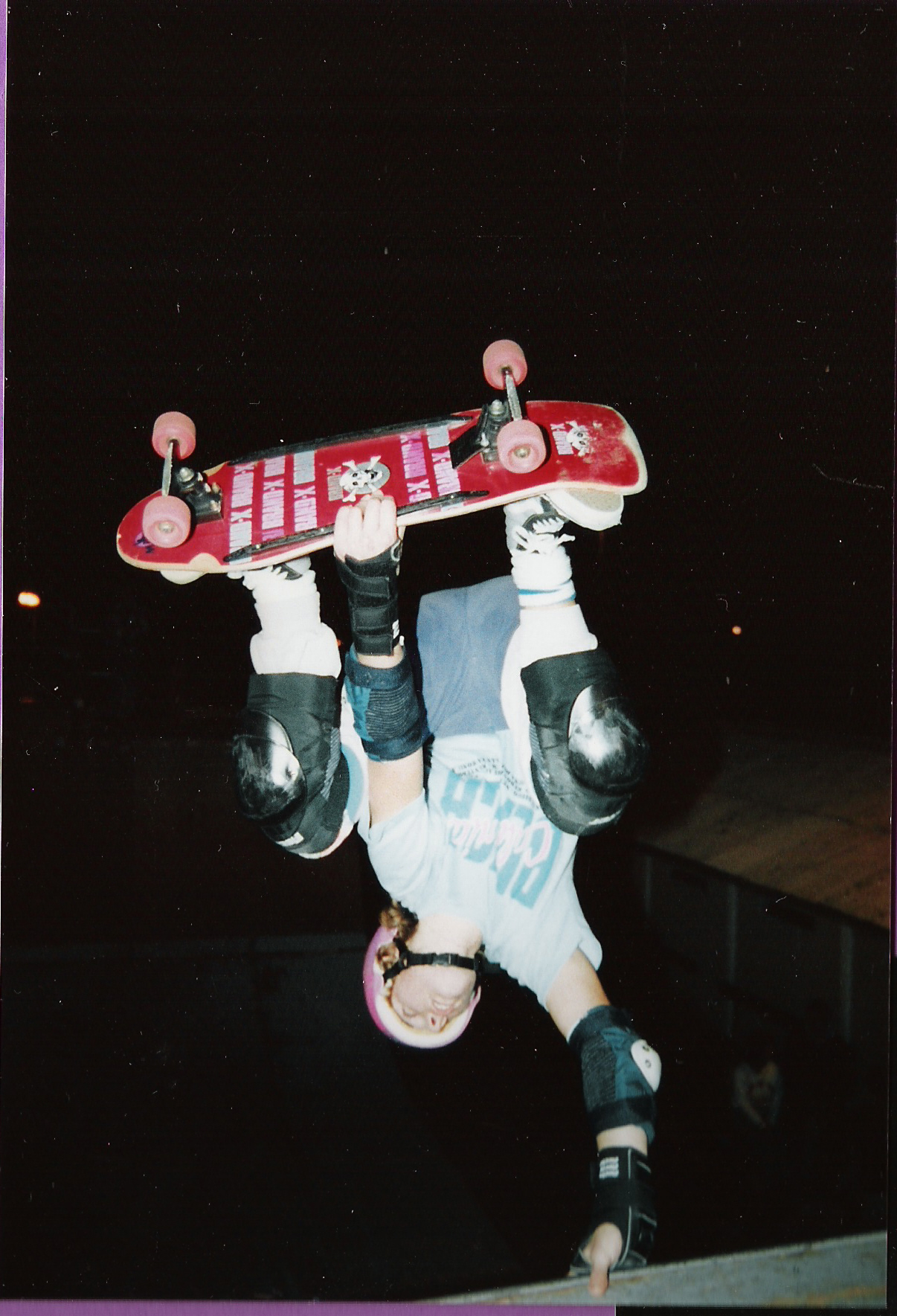
Handplant, Southsea Vert evening sesh, 1987
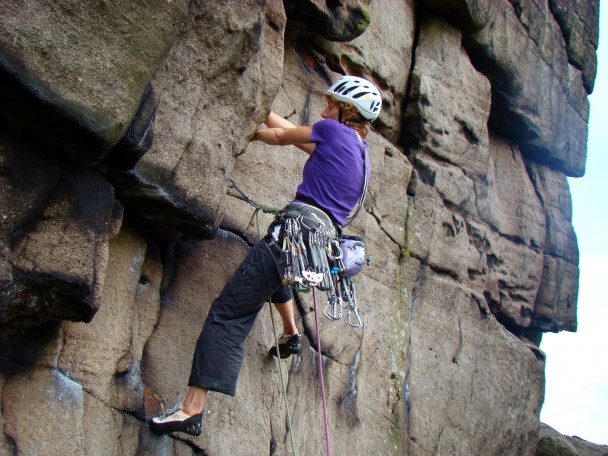
Getting to grips with The Rasp – E2, 5b Higgar Tor, Summer 09 – Photo: Pete Saunders
Hanging out in an outrageous position on “Dreadnought” E3, Berry Head, South Devon, UK Photo: Pete Saunders
“The Rasp”, Higgar Tor, Derbyshire, UK; Steep, sustained and with the exciting crux move reserved for the finish! Photo: Pete Saunders
Hamming it up with school friend, “Mad Fran” at a concert by Bjorn Again, an Abba tribute band.
The ominous overhang of “The Sentinel E2”, Burbage North, Derbyshire, UK Photo: Pete Saunders
Interview by Christine Cauble

